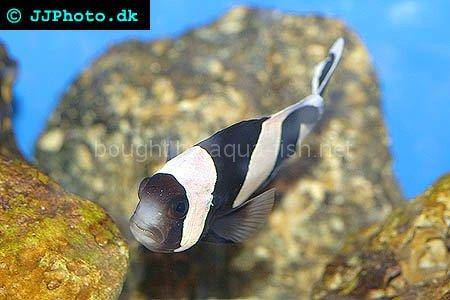Brown Saddle Clown
This fish is known as Brown Saddle Clown and the correct latin name is Amphiprion polymnus. It belongs to the Damsel family. (e) It's origin is Indo-Pacific. (e)
Brown Saddle Clown can grow up to 13 cm what is approximately 5 inches. In general, 1 specimen requires at least 1560cm2 of water surface which is approximately 241 square inch. We recommend you to keep it in fish tanks which are medium. (e) Medium aquariums have at least 113 Litres (30 US Gallons). Large aquariums have at least 265 Litres (70 US Gallons). Very large aquariums hold at least 700 Litres (185 US Gallons).
It is not very difficult to keep the Brown Saddle Clown fish. (e) The specific gravity (SG) should be between 1,020 and 1,025, the temperature between 23°C (73.4°F) and 26°C (78.8°F). The recommended pH level is between 8.0 and 8.3 since marine fish are used to these levels in general.
Only advanced fish keepers should keep Brown Saddle Clowns, because they may experience problems getting used to the new tank. Also this species is rarely found in pet stores.



Related fish profiles in the database
Feel free to share your experiences regarding keeping Amphiprion polymnus below. Every message will be held for approval by our moderators. It usually takes 24 hours to publish your comment. Before you ask anything, browse the questions page, please.
Character and suggestions regarding care
Like other Clowns, this species might become aggressive.Brown Saddle Clown can grow up to 13 cm what is approximately 5 inches. In general, 1 specimen requires at least 1560cm2 of water surface which is approximately 241 square inch. We recommend you to keep it in fish tanks which are medium. (e) Medium aquariums have at least 113 Litres (30 US Gallons). Large aquariums have at least 265 Litres (70 US Gallons). Very large aquariums hold at least 700 Litres (185 US Gallons).
It is not very difficult to keep the Brown Saddle Clown fish. (e) The specific gravity (SG) should be between 1,020 and 1,025, the temperature between 23°C (73.4°F) and 26°C (78.8°F). The recommended pH level is between 8.0 and 8.3 since marine fish are used to these levels in general.
Only advanced fish keepers should keep Brown Saddle Clowns, because they may experience problems getting used to the new tank. Also this species is rarely found in pet stores.



Related fish profiles in the database
- Abudefduf Notatus (Yellowtail Sergeant, Dusky Damsel)
- Abudefduf Saxatilis (Sergeant Major Damsel, Striped Sergeant, Damsel Fish, Five Finger)
- Abudefduf Sexfasciatus (Scissortail Sergeant, Striptailed Damselfish, Six-Barred Sergeant-Major)
- Abudefduf Sordidus (Blackspot Sergeant)
- Abudefduf Vaigiensis (Indo-Pacific sergeant, Sergeant major, Five-banded Sergeant-major, Five-banded Damsel-fish)
- Acanthochromis Polyacanthus (Spiny Chromis, Spiny Puller)
- Amblyglyphidodon Aureus (Yellow Damsel, Lemon Damsel, Lemonpeel Damsel)
- Amphiprion Akindynos (Barrier Reef Anemonefish)
- Amphiprion Bicinctus (Twoband Anemonefish)
- Amphiprion Chrysogaster (Mauritian Anemonefish)
- Amphiprion Chrysopterus (Orange-Fin Anemonefish)
- Amphiprion Clarkii (Clarkii Clown)
- Amphiprion Ephippium (Fire Clownfish)
- Amphiprion Frenatus (Tomato Clown, Tomato Anemonefish)
- Amphiprion Ocellaris (Black and White False Ocellaris Clown, False Clown Anemonefish)
- Amphiprion Percula (True Percula Clown)
- Amphiprion Perideraion (Pink Skunk Clown)
- Amphiprion Tricinctus (Three-Banded Anemonefish, Maroon Clownfish)
- Chromis Caerulea (Green Chromis)
- Chromis Chromis (Damselfish)
- Chromis Cyanea (Blue Reef Chromis Damsel)
- Chromis Viridis (Blue Green Damselfish)
- Chrysiptera Brownriggii (Surge Damselfish)
- Chrysiptera Cyanea (Sapphire Devil)
- Chrysiptera Parasema (Goldtail Demoiselle)
- Chrysiptera Springeri (Springer’s Damoiselle)
- Chrysiptera Talboti (Talbot’s Demoiselle, Talbot’s Damselfish)
- Chrysiptera Unimaculata (Onespot Demoiselle)
- Dascyllus Aruanus (Whitetail Dascyllus, 3-Stripe Damsel)
- Dascyllus Reticulatus (Reticulate Dascyllus, 2-Stripe Damsel)
- Dascyllus Trimaculatus (Threespot Dascyllus, 3-Spot Domino Damsel)
- Hypsypops Rubicundus (Garibaldi Damselfish)
- Microspathodon Chrysurus (Bluespot Damsel, Yellowtail Damsel, Jewel Damsel)
- Neoglyphidodon Melas (Bowtie Damselfish)
- Neoglyphidodon Oxyodon (Bluestreak Damselfish)
- Pomacentrus Alleni (Andaman Damsel)
- Pomacentrus Moluccensis (Lemon Damsel)
- Pomacentrus Pavo (Sapphire Damsel)
- Pomacentrus Similis (Similar Damsel)
- Premnas Biaculeatus (Spinecheek Anemonefish)
- Saltwater aquarium heater
- Saltwater aquarium lights
- Saltwater aquarium filters
- Saltwater tank aeration
- Marine fish diseases
- Protein Simmers in the Saltwater Tank
- Setting up a Saltwater Tank
- Saltwater Fish Tanks
- Cleaner Shrimp
- Pajama Cardinals
- Banded Butterflyfish
- Black-Ray Goby
- Blue-Banded Goby
- Blue Chromis
- Blue Green Chromis
- Blue Spot Butterflyfish
- Breeding Seahorses
- Cleaning Goby
- Common Seahorse
- Domino Damselfish
- Dragonface Pipefish
- Drawf Seahorse
- Fire Goby
- Ghost Pipefish
- Golden Damselfish
- Humbug Damselfish
- Lemonpeel Dwarf Angelfish (Centropyge flavissima) Care
- Longfin Bannerfish
- Majestic Angelfish Care
- Neon Velvet Damselfish
- Northern Seahorse
- Pyramid Butterflyfish
- Spotted Watchman Goby
- Tips on Yellow Longnose Butterflyfish Care
- Two Spot Goby
- Yellow Longnose Butterflyfish
Feel free to share your experiences regarding keeping Amphiprion polymnus below. Every message will be held for approval by our moderators. It usually takes 24 hours to publish your comment. Before you ask anything, browse the questions page, please.
Document modified on Sun Apr 24 5:58:33 UTC 2011
Document created on Mon Dec 3 9:39:56 UTC 2007
How to cite this page? Use the following HTML:
edit this page or create a new fish profile "Brown Saddle Clown." saltwater.aqua-fish.net. Mon Dec 3 9:39:56 UTC 2007.
Aqua-Fish.Net. Fri Jul 18 23:51:34 UTC 2025 https://saltwater.aqua-fish.net/?brown-saddle-clown.